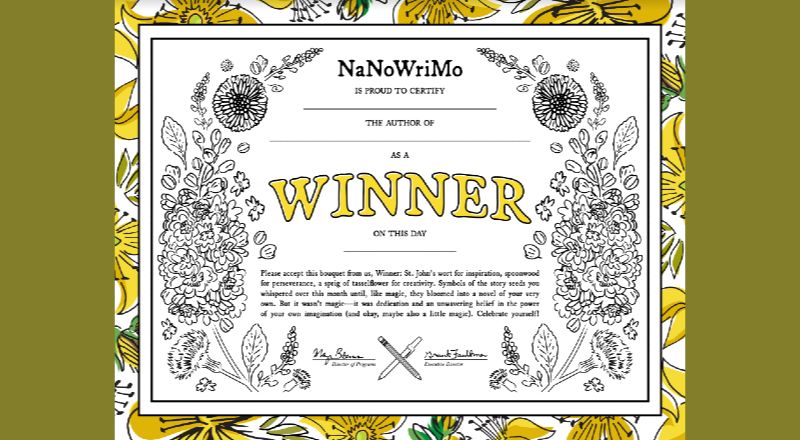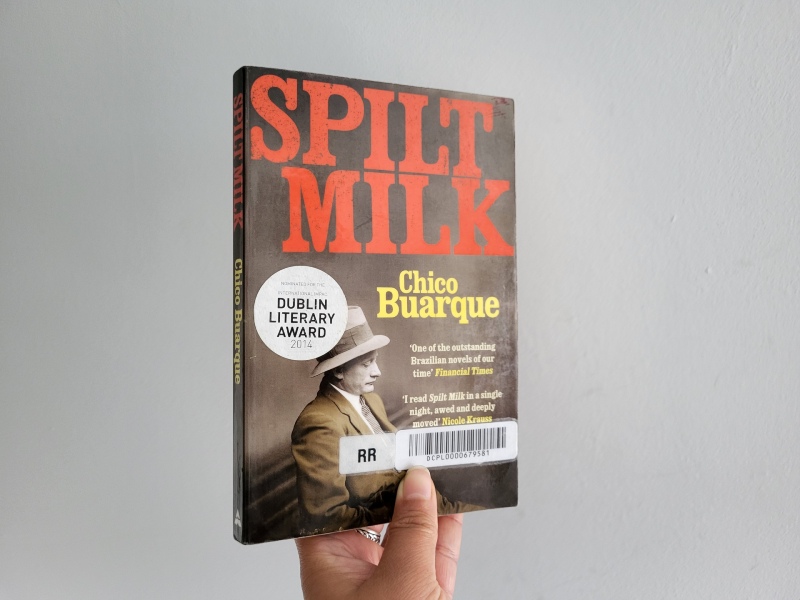For the fourth time, I’ve challenged myself to do NaNoWriMo.
I have won every year, hitting the 50K word target on 22nd November in 2023.
For the fourth time, I’ve worked on the same project.
During the first two years, I worked on the primary and second POVs of the story. The third and current years, I started editing the book.
My last NaNoWriMo’s task is to evaluate my process and achievements, so I can do better next time.
So here is what I’ve done and learned doing NaNoWriMo in 2023. You are getting a much longer post this year, but I hope it’s helpful.
(here are my notes for NaNoWriMo 2022 and NaNoWriMo2021)
A bit of context
Every person is different,and so is their creative process. Their life circumstances, background, and previous experience play a crucial role in how and what they can accomplish.
For this reason, let me give you a bit of context before I talk about how things went.
- I work for myself and from home, which gives me almost 100% control of my schedule.
- I’ve been writing fiction since forever, and I’ve published poems and short stories, but I have yet to make money out of it.
- I am a former journalist and public relations manager. I currently work with content marketing. I am used to writing a lot and under pressure.
- I live in a decent place with a supportive fiancé, and I don’t have children or pets.
- I have spent tons of hours doing courses, reading books, and watching videos about storytelling.
- One of the services I provide is professional beta reading.
- My skill set is all about project management. Planners, lists, and deadlines are my jam.
- I suffer from severe neck and back pain due to decades of too much writing/reading, poor posture, and not enough exercise.
- I am a plotter, not a pantser. I need an outline to get my story started.
For this year, I was editing a literary mystery novel, meaning I wasn’t writing many new words. I called myself a NaNoWriMo rebel and added to the dashboard the total number of words of the chapter I had edited each day.
My Preptober and Workbooks for NaNoWriMo 2023
To get anything done, I need preparation and order. This is why Preptober and workbooks are so important to me. Once I know what I am doing, all is good.
For 2023, I created three workbooks: Preptober, Nano Workbook, and Novel’s Supporting Materials. They were based on info and ideas from many places, plus things I added and adapted for myself over the years.
My main sources for the workbooks are the following:
- Save The Cat Starter Kit –
- https://www.jessicabrody.com/save-the-cat-starter-kit/
- Heart Breathings’s Plot your Novel – https://heartbreathings.com/how-to-plot-your-novel-part-one/ or
- Heart Breathings’s Preptober Planner – https://heartbreathings.com/the-2023-preptober-planner-is-here/
- Natalia Leigh’s Preptober WorkBook – https://www.natalialeigh.com/preptober-workbook.html
I am not an affiliate or partner of any of the sources above. I am just giving credit to whom it’s due, ensuring I respect their copyright.
My Preptober is all about preparation, as it should be. I use the time to create to-do lists, review what I did last year, and find where my stuff is in case I buried my files in some mysterious place.
The biggest challenge this year was to refrain from starting to edit straight away. Once I listed my tasks, all I wanted was to get them done. But I managed to wait until November.
My 2023 Preptober Workbook had the following pages:
- Cover page – because it has to look cute.
- Brainstorming page – a black page (dumping space) for suggestions and ideas.
- To-do list page – two pages listing the good ideas brought up by the brainstorming: one for what should be done in October and another for November.
- Calendar – one for October and another for November, organising tasks, listing possible meetings, setting deadlines, etc. I use this one by GeneralBlue.
- Background notes – blank page divided in half. Each half is for taking notes about what I call Background topics: Events, Playlists, Rewards, and Meal Plan.
- Inspirational Board notes – My Inspirational Board is no more than a sturdy piece of paper with inspirational quotes and images. It works as a reminder of why I do what I do. This workbook page is for improvement notes.
- Pain Management – notes about how to minimise the extra pain I go through due to the increased amount of typing.
- Research – list of things I want to watch or read in October to help me with my plot or character development.
- Buy list – list of things I needed to buy beforehand, such as rewards and food.
- New daily journal – this year, I wanted to create an upgraded daily journal.
To be clear, all the above are blank pages, and I spend the month of October filling them up and deciding what is going to be implemented in November.
At the end of October 2023, I had worked on extended character and setting sheets, created a list of events, and prepared a new Inspiration board, among other small things. I then created my NaNoWriMo Workbook, which included these pages:
- Cover page.
- Writing routine: when I would write, where, and how.
- Word count tracker: table style + colouring page + daily countdown.
- Daily journal pages with mood, energy, meal, pain, and sleep trackers.
- End-of-the-challenge evaluation.
- Blank pages for Nano final graphs and winner certificate.
- Meal plan.
- Blank page for notes.
- November Calendar filled with expected events.
Finally, to help me during the editing process, I created another workbook with my Novel’s Supporting Materials:
- Cover page.
- Story’s chronological timeline.
- Acts 1-3, beat by beat, based on Save the Cat structure.
- Character sheets – illustrative image, detailed profile, arc, and notes.
- Setting sheets – for new or underdeveloped settings: act/chapter + description + use of five senses.
- Scenes sheets – for new and missing scenes: act/chapter, characters, setting, inciting incident, turning point, crisis, climax, and resolution.
It looks like a lot but most of these pages I’ve been improving over the years. And creating workbooks actually fires up my imagination.
But I understand so many pages can feel overwhelming and exhausting for many people. So, take only what makes sense to you.
Doing it again
Let me talk now about what I did exactly as previous years – because it has been working so far.
Consistency is key
Daily consistency means everything to me. I know some people can write only on weekends and keep the flow. Others start slow and then speed up their pace as the deadline approaches.
Neither works for me. I need to do a little bit every day, or I lose interest and drive. The story starts to fade away.
I set a goal of one chapter per day. As my chapters tend to have around 2000 words, it was a doable amount for 1-hour to 1,5-hour daily work. And it gets me to 50k before the end of November.
I also refrain from the temptation to do more than my daily quota. It was tempting to continue on when the chapters were short or easy to edit. But I would end up having to stop in the middle of a chapter because I needed to go to work. Or I would burn out. Or hurt my back. Knowing when to stop is fundamental.
Minimise friction
Another thing I continue to do, which I learned from reading Atomic Habits by James Clear, is doing my best to minimise friction. The idea is that the easier it is to do something, the more likely you are to do it.
I am a lazy starter. Once I get the ball rolling, yes, I get lots done. But to get myself into starting anything, even something I want to do, is a struggle.
Please allow me to blame it on inertia. The forces of the universe are against me. To minimise their power, I leave everything ready beforehand:
- On the day before, I choose where I will do the work.
- I leave the laptop on the top of a foldable (breakfast) tray exactly where I want it to be.
- I leave my workbooks nearby, along with a notebook, a bottle of water, and a pen.
- Before going to bed, I get the laptop, open the document on the right chapter and leave it there – I use Google Docs.
In the morning, I only need to sit down and fire up the laptop to start writing.
Fighting the weather
I live in Ireland, but I am originally from Brazil. The almost 14 years I’ve been living here have not made me able to deal well with the cold and dark days.
November is always a challenging month for me, and 2023 went from warm to freezing quickly. Getting myself out of bed was no fun.
The trick is to stay wrapped in a blanket all the time, protecting myself from the temperature shock. And, yes, I write in my pyjamas because I can 🙂
Aiming at top energy’s hours
I believe I can meet my NaNoWriMo target because I do the work during my optimal hours.
Over the years, I’ve learned that my most productive time is the first hours of the morning. Even if I have a bad night, I can still get something done if I start it as soon as I wake up.
It’s also my most creative hour. I guess it’s probably because I leave the bed straight to the computer. I am still in some kind of dreamlike state, connected to the unconscious side of my brain.
While editing, I had no issues whatsoever with tiredness or mental blocks. But I did have a few when I was staring at blank pages on past NaNoWriMos.
When it happened, I still wrote early in the morning. But, when I didn’t meet the daily target, I worked again later in the day during a virtual meeting. A long break from the task and the group energy pushed me through.
Lessons learned
Still, I did try some new things. And others didn’t work in the same way this year.
Pain management
In the previous years, I struggled with all sorts of pain more or less from Day 15 to the end of November. Doing more writing and sitting on top of the amount I already do puts too much strain on my body.
This year, I created a pain management routine. It included stretching and relaxing exercises I had to do straight after finishing my writing and later in the day. I also had an emergency/recovery routine ready in case the worst happened.
The results were amazing. I felt little to no extra pain throughout the month.
I am not going to share the details here because I believe one should consult their doctors and physical therapists for stuff like this. But I can tell it was about simple things, such as:
- Laying down on the floor
- Neck and back stretching exercises
- Finger & hand massage roller
- Massage ball
- Yoga
- Wrist brace (rigid splint)
Organising the day before
Another thing I did this year was to have a quick look at the next-day chapter beforehand. No judgement, just enough to have an overall feel of what was coming.
During the day, I caught myself thinking about it now and then. I believe my subconscious worked on it on and off, even while I was asleep. Because when I woke up in the morning, I knew exactly how and what I should do.
Writing by myself
Due to many reasons, some out of my control, I did all my NaNoWriMo alone this year. I didn’t join any in-person or virtual meetings, nor participated in online sprints.
I think I didn’t miss it because I was editing. Dealing with a blank page feels much more challenging, and, as I mentioned, the energy of the group can be fundamental.
But I wasn’t feeling social, and I didn’t want to upset other people with my problems. I am glad it didn’t make a difference this year, but I am sure I will want to join the groups next year.
Simplify to optimise
Around the middle of the month, I had given up on my colouring page and daily countdown. They lost the appeal, maybe because I wasn’t truly writing new words.
The journal’s trackers also felt random and repetitive. It was good to have the topics (mood, energy, meal, pain, and sleep) as a reference for what to mention in the journal’s notes. But the grading process didn’t feel useful. I need to rethink it for next year. Maybe I will create line graphs instead.
The journal’s notes continue to be the most useful tool of the workbook. I write only a few lines about the good, the bad, and the ugly of each day. But they help me to reflect on what I am doing and make quick adjustments along the way.
I also believe it was a good idea to add a page for a written overall evaluation. And printing out the NaNoWriMo’s graphs. They will be useful next year. But I’ll try and see what else can be simplified.
The rewards issue
Once again, the rewards. So, I tried again the one-chocolate-a-day thing. For this year, I bought a bag of Butlers’ Assorted Truffles. They come with 30 units, one for each day of the month. Perfect.
Very bad idea.
It started well, but then I went through some personal issues and end up eating a bunch of chocolates in one go. I wasn’t far from hitting the target, and I told myself I could because I was ahead of schedule. Then I lost count (did I really?) and ate the rest of it because, well, in for a penny… Then I felt bad because I am serious about losing weight and had been doing so well…
If I do it again next year, I need to think of a different kind of reward. Or maybe leave the bag with my fiancé to stop me from “losing count.”
To print or not to print?
I like to edit longhand. The idea was to print my chapters before and after editing them during NaNoWriMo.
I quickly noticed that doing it before the editing had no benefit. I didn’t have the time to go through the chapter.
It made more sense to print them after. If nothing else, I would have a hard copy of my first draft. But it felt useless once again, but for a very different reason.
As I went chapter to chapter, I noticed way too many plot holes, mostly about characters’ profiles and timeline. Meaning that what I was printing wasn’t yet a clean first draft. So, I stopped printing and did online backup only.
In case you are wondering, I download my Google doc every day, then save it on my laptop and on Dropbox. But I don’t keep all the old versions. Only the most recent of each NaNoWriMo.
More detailed outline and timeline
If I learned one thing is that the editing would have gone smoother if I had the followiing on my hands from day one:
- A detailed outline and character sheets – to spot inconsistencies.
- A synopsis of each chapter – to track the issues.
- A day-by-day timeline – to manage the order of the facts.
Still, I think the above is relevant to me because my manuscript is a mystery book with two POVs and two timelines. If it had a straightforward storyline, I probably would have found fewer problems to fix.
Reviewing someone else’s work
This is how it felt editing a story I haven’t set eyes on for at least one year. It was like I hadn’t written it. And the detachment helped to edit the words. I had no issues when I had to delete things or move them around.
The good news is that it probably means that my writing has improved (fingers crossed!).
But I must say that many paragraphs made absolutely no sense. Especially the first 50k of the book, which I wrote during the pandemic. For example: two characters were talking on the phone, and then one handed a piece of page to the other. And no, my book is not sci-fi or fantasy.
I think writing fast, half awake and while on lockdown did a number in my head. But what matters is that the job got done.
What is next?
Once I finished NaNoWriMo 2023, I continued working on my novel until 30th November. Overall, I managed to edit acts 1 and 2, meaning around 75k words.
But I still have to do act 3, which is about another 25k words. And I haven’t made much progress for many reasons.
First, because I wanted to take some time to reflect on what I had done. I wanted to work on my own evaluation and write this article. I also needed to attend to other issues that had been on the backburner.
Still, in all honesty, I’ve slowed down because Act 3 is a big mess. Most chapters are repetitive and boring. Or just missing. I need to rewrite the entire lot on top of creating some new pages from scratch. And I find writing endings very difficult.
Hopefully, I will get back to it over the next few days. I really want to have the first draft complete before 2024. Maybe I need to create an Act 3 workbook to cheer me up 🙂
Will I be doing NaNoWriMo in 2024?
Yes, probably yes. Unless something stops me from doing it, I will do it again. But I don’t think I will be working on the same manuscript. Even if I don’t finish it over the next months.
I am not convinced that NaNoWriMo is a good environment for editing a novel. The speed and word count got me messing around too much. I did a lot, but I still have a lot to do.
During my next NaNoWriMo, I hope to be working on a first draft. This brand-new story also needs to have a straightforward storyline or follow a detailed outline. This is my assessment. But you never know. I might think differently when the time comes.




